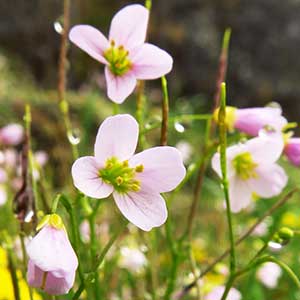Cardamine pattersonii
Cardamine flexuosa
Saddle Mountain bitter-cress
wavy bitter-cress, wood bitter-cress, woodland bitter-cress
cylindrical, slender, 0.5–1.5 mm diam.
absent.
(simple from base), erect, (not flexuous), unbranched or branched basally, 0.6–3 dm.
erect, ascending, or decumbent, branched or unbranched, (0.6–)1–5 dm, (slightly flexuous).
rosulate or not, 3 or 5-foliolate, 1–6 cm, leaflets petiolulate;
petiole 0.4–2.5 cm;
lateral leaflets similar to terminal, considerably smaller;
terminal leaflet (petiolule 0.1–0.4 cm), blade obovate to orbicular or subcordate, 0.3–1.5(–2.0) cm × 2.5–16(–18) mm, base obtuse to rounded or cordate, margins entire or dentate to slightly sinuately lobed.
(often withered by anthesis), not rosulate, 5–15-foliolate, (2.7–)4–14(–19) cm, leaflets petiolulate;
petiole 0.7–5 cm, (ciliate or not);
lateral leaflet blade oblong, ovate, or elliptic, smaller than terminal, margins entire, repand, crenate, or 3 (or 5)-lobed;
terminal leaflet (petiolule 0.3–1.7 cm), blade reniform, broadly ovate, or suborbicular, 0.5–2.5 cm × 4–30 mm, margins repand, crenate, or 3 or 5-lobed.
2–4, 3 or 5-foliolate, blade similar to basal, gradually reduced in size as bract, distalmost ones subtending pedicels of flowers (usually simple);
leaflet blade or bract linear to linear-oblanceolate, 0.2–0.8 cm.
3–15, 5–15-foliolate [leaves (2–)3.5–5.5(–7) cm, including petiole], petiolate, leaflets petiolulate;
petiole base not auriculate;
lateral leaflets similar to basal, (0.4–2.5 mm wide).
bracteate throughout.
ebracteate.
sepals oblong, (2–)3 × 0.7(–1) mm, lateral pair not saccate basally;
petals purple or pink, obovate, 6–9 × 3–4 mm, (not clawed);
filaments: median pairs 3–3.5 mm, lateral pair 2–2.5 mm;
anthers oblong, 0.7–1 mm.
sepals oblong, 1.5–2.5 × 0.7–1 mm, lateral pair not saccate basally;
petals white, spatulate, 2.5–4(–5) × 1–1.7 mm; (stamens rarely 4, lateral pair absent);
filaments 2–3 mm;
anthers ovate, 0.3–0.5 mm.
divaricate-ascending, (10–)15–30(–45) mm.
divaricate or ascending, (5–)6–14(–17) mm.
linear, (torulose), 2–3 cm × 1–1.5 mm;
ovules 14–20 per ovary;
style 2–4 mm.
linear, (torulose), (0.8–)1.2–2.8 cm × 1–1.5 mm;
ovules 18–40 per ovary;
style 0.3–1(–1.5) mm.
brown, oblong to ovoid, 1.7–2.2 × 1–1.5 mm, (winged distally).
brown, oblong or subquadrate, 0.9–1.5 × 0.6–1 mm, (narrowly margined or not).
= 32.
Cardamine pattersonii
Cardamine flexuosa
Of conservation concern.
Cardamine pattersonii is known from Saddle Mountain and Onion Peak in Clastop County.
(Discussion copyrighted by Flora of North America; reprinted with permission.)
According to J. Lihová et al. (2006), the populations referred to Cardamine flexuosa in North America comprise two taxa of different polyploid origins and evolutionary histories: tetraploid C. flexuosa (2n = 32), native to Europe, and the octoploid taxon informally called “Asian C. flexuosa” (2n = 64), native to eastern Asia. For the latter, the name C. flexuosa subsp. debilis can be used. Nevertheless, these two taxa should be recognized at species level and the correct name for the Asian species should be sought. Based on available data, both taxa occupy the same habitats in North America, but the Asian taxon is much more widespread. The occurrence of European C. flexuosa was, until now, confirmed only for Washington, where both taxa have been recorded. More detailed studies of the North American distributions of both these weeds are needed.
(Discussion copyrighted by Flora of North America; reprinted with permission.)
- Local floras:
BC,
OR,
WA
- Local Web sites:
CalFlora,
CalPhotos,
Flora NW,
Go Botany,
IL Wildflowers,
LA Plants,
MD Biodiversity,
MI Flora,
PNW Herbaria
WildflowerSearch
iNaturalist (observations)
USDA Plants Database
- LBJ Wildflower Center
- SEINet
- Plants of the World Online
- Encyclopedia of Life
- Wikipedia
- Google Image Search


